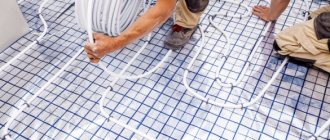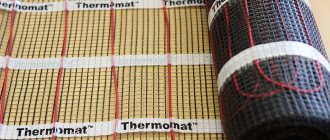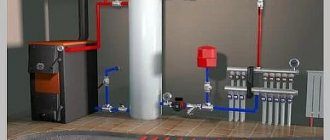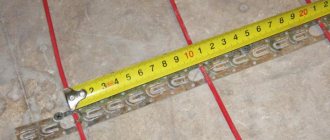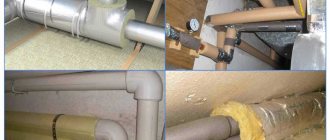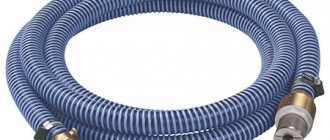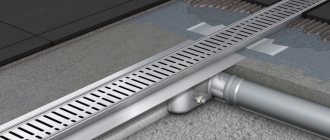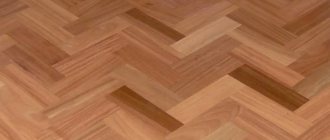Under any heated floor, it is necessary to place a substrate so that it holds back the hot air when heated. This is important for providing thermal insulation in a room or an entire house. For each design, materials should be selected individually. Mats for heated floors are necessary: they not only retain warm air, but also provide good thermal insulation. Let's look at the main properties of this material and look at the main secrets of installation.
Mats for warm water floors Source mainavi.ru
Functions of construction mats
Expanded polystyrene for underfloor heating ensures the proper functioning of the heating structure. To do this, it is important to provide a good base for the warm water floor. Mats help distribute heat over the entire surface and retain it even after the energy supply for the functioning of the heated floor is stopped.
Also, such mats provide complete insulation from cold air. Thus, during cold weather, cold will not penetrate into a room with a warm water floor. Condensation does not form if such a substrate is present. Accordingly, there is no mold on the walls either.
Material structure Source allelectrics.ru
Advantages
- The high density of expanded polystyrene provides higher strength indicators, so thermal insulation panels do not change their original dimensions.
- We can say that all these products are certified according to European standards. In particular, self-extinguishing raw materials are used in production.
- Installation of heating pipes is carried out according to installation marks specially applied to the surface. This allows you to effectively distribute heat throughout the room.
- Both “wet” and semi-dry screeds can be laid on such a coating with equal success.
- Another important difference is that it is equipped with special clamps - they allow you to easily and quickly install the underfloor heating pipeline system.
Types of mats
There are several types of mats for warm water floors. They differ in functionality and installation conditions. Individual material is selected for each case. Therefore, before purchasing, it is important to determine the necessary characteristics and choose the appropriate type. Let's look at the main types of polystyrene foam for heated floors.
Roll mats
This type of insulation for a warm water floor is an insulating material rolled into a roll. The thickness of the rolled mats does not exceed 10 mm. The material itself is covered with a special aluminum film, the function of which is to contain and distribute heat.
However, the power of such insulation will be small. It is better to use it as a substrate only if the floor has already been insulated before. Rolled mats on their own will not cope with the heating task properly, since all the warm air will go into the base of the floor.
Rolled mat Source estpak.ru
Expanded polystyrene boards
Expanded polystyrene under a warm water floor is used as a reliable substrate. This material is divided into two types:
- Styrofoam;
- extradiated polystyrene;
It is much cheaper to lay polystyrene foam under a warm floor, but it is highly susceptible to mechanical changes. That is why it is important to pay attention to the density of the foam so that it can withstand heavy loads on the surface of the flooring.
Polystyrene for heated floors can withstand very heavy loads and does not deform under mechanical stress. Other substrates can be added to expanded polystyrene boards to enhance the thermal insulation effect.
Expanded polystyrene mats Source spateplo.ru
Foiled polystyrene foam
Such mats for heated floors are made of polystyrene foam, on top of which a layer of foil is applied. This helps further insulate the heat and prevent it from escaping. There are also several types of insulation of this type:
- Panel . Several panels of the same size, which are connected to each other with a special foil film. It is better to carefully treat the joints with waterproof tape.
- Tiled . They are divided into several identical tiles, which during installation must be fastened together using special locks.
A special mesh is applied to the panels and tiles, which helps to position the heating pipes evenly. They are attached to special brackets. Mats for heated floors made of foil polystyrene foam enhance the protection of the room from the penetration of cold due to their structure.
Foil expanded polystyrene Source smstroi.ru
See also: Catalog of companies that specialize in engineering systems and related work
Mats with "bobs"
Some mats for warm water floors have small protrusions, between which pipes for future additional heating are placed. They do not need to be attached to special brackets; simply placing them on the materials is enough. These protrusions are called “bosses” in construction.
The shape of the protrusions can be completely different, as well as the height with distance. It all depends on the characteristics of the hose, especially the length and diameter. Special markings help place heating equipment in a variety of configurations. Expanded polystyrene for a warm water floor with “bobs” is ideal as a substrate.
This type of polystyrene foam is secured with locks. You must first install one polystyrene foam board, and then attach all the others. Almost all the same work is done as when laying laminate: the panel is tilted at an angle, attached to the previous one and snapped into place. At the end of the work, it is important to check the strength of all connections.
Mats with “bobs” Source sst-nsk.com
What are the characteristics of polystyrene foam for heated floors?
- Low thermal conductivity, on the order of 0.037-0.052 W/m*K, can guarantee the absence of thermal dispersions.
- The material from which these products are made has a density of about 40 kg per m3, that is, they are resistant to all possible mechanical influences.
- In addition to the laminated coating, centering stops located at the ends of the panels also protect against moisture. Excellent adhesion of the plates to each other eliminates the appearance of cracks and cracks in the joints.
- They differ in their overall dimensions (1.0 * 1.0 m; 0.8 * 0.6 m) and, as a consequence, the pitch of pipe laying.
- Expanded polystyrene, with its physical properties and cellular structure, contributes to sound insulation and sound absorption.
Features of the material
Mats for heated floors have several distinctive features. Expanded polystyrene retains heat well and helps it spread throughout the room. However, this is not the only advantage of insulation.
The key distinctive features of underfloor heating mats include:
- high sound insulation;
- almost no steam escapes;
- no condensation forms;
- there is no natural environment for the development of microorganisms;
- performs its main functions for a long time.
Depending on the type of substrate, the characteristics differ, but standard polystyrene mats have all of the listed properties. The material also withstands heavy loads so that the floor does not deform and the heating device does not fail.
Material structure Source ovk-system.ru
How to choose the right material
In order for polystyrene for underfloor heating to last for many years, special attention should be paid to the choice of material. It is necessary to study the basic properties of each type and determine which of them are suitable for heat supply equipment.
You should choose according to the following criteria:
- loads that the material can withstand;
- features of the premises;
- waterproofing;
- density;
- pipe diameter
For the lowest floors, it is best to choose denser slabs. This way, cool air will not penetrate into the room, and warm air will not leave. You cannot use roll-type mats for water-heated floors in such places, since they are too thin and are not able to perform their functions properly. Can be used as an additional source of thermal insulation.
Heating elements Source stem-energy.ru
In rooms that really need to retain heat, it is best to use polystyrene foam mats with a foil surface. They have the highest thermal insulation properties. In addition, such mats for heated floors can withstand heavy loads, unlike foam plastic. Therefore, it can be installed in rooms with the highest traffic.
Preparatory work, installation and connection
Laying mats is carried out only on a flat base, so it must first be prepared in a special way.
Installation of heated floors Teplolux heating mats
Preparing the base
To prepare the surface for a heated floor under tiles, you need to remove the old covering and fill the floor with a concrete screed. If, however, there is a smooth surface under the old floor covering, then you can simply putty the cracks.
After the base has dried, a thermal insulation layer is laid. PPU and expanded polystyrene boards are suitable for this, as they are quite rigid and resist deformation well. But their thickness must be at least 10 mm.
Installation of thermomat
The first step is to make markings taking into account the following requirements:
- a distance from the walls of at least 10 cm;
- from heating radiators - at least 15 cm.
In addition, you need to plan the arrangement of furniture, since mats are laid under furniture with legs of at least 10 cm. If objects without legs, or the height of the legs is less than specified, then it is prohibited to install the system under them.
Installation of a heated floor under porcelain stoneware begins from the place where the thermostat is installed to the opposite obstacle (wall or object) under which the system will not be installed. Having reached the wall, the mesh is cut off, the mat is rotated 90 degrees and spread in the opposite direction. The number of such turns is not limited and is determined by the area of the room.
Having covered the working area with mats, they must be secured using cement-sand mortar or heat-resistant adhesive. To do this, each heating mat is raised and a screed is applied to the insulation spread on the floor. After which, the mat is put back and pressed down with a beam. Excess cement mixture that appears must be removed along the height of the cable. Then, you can immediately begin laying the tiles.
If desired, you can fill the warm floor with another layer of screed. Thanks to it, the floor will become more monolithic and heating will be more uniform.
Connection
The heated floor heating is turned on and off using the thermostat to which it must be connected. In addition, it protects the cable from overheating and helps maintain a comfortable temperature level in the room. This device operates automatically, and when the floor heats up to the set level, the power supply is turned off.
The thermostat should be connected according to the detailed diagram available on the device body. It is mounted to the wall, at a height of 30 - 120 cm from the floor. A cable is pulled to the thermostat, through which energy will be supplied.
The heating elements are connected to it by a coupling. If the area of the mat is not large, it connects to a regular outlet. If its length is more than 10 m2, then the feeding cable should be routed to a separate machine.
In addition, a sensor should be connected to the thermostat; it is needed to calculate the temperature level. To install the sensor signal cable, you need to make a channel in the floor, which should be placed between the loops of the heating cable. The temperature sensor, together with the wire, is placed in a corrugated pipe, and the free end is well insulated to prevent moisture from entering.
After connecting the device and drying the adhesive, the system should be allowed to work for 10 - 15 minutes. If the floor becomes moderately hot, warms up to 60 degrees, then it is suitable for use.
Video description
How to install heated floors on mats - in this video:
Step 1. Preparation
The surface on which the underfloor heating will be laid is well prepared. It needs to be inspected for roughness and chips. All holes must be carefully repaired and the floor itself leveled. Otherwise, the floor covering will fit very poorly on the slabs. It would be best to put another layer of concrete screed.
Concrete screed Source homemasters.ru
Briefly about the main thing
Insulation for a warm water floor should be selected very carefully. It should not let in the cold and allow warm air to escape. The purpose of the underlay under the water floor is to distribute heat evenly throughout the room. An excellent option for underlay would be mats for heated floors. They come in different types, and accordingly, their characteristics are not the same.
It is important to select mats based on the characteristics of the room. Thin materials are not suitable for basements: they can only be used as enhanced heating. Expanded polystyrene with “bobs” is best suited, because it is easiest to place a heated floor heating system in it. The main thing is to take a responsible approach to the selection and installation of the material, then the warm floor will last for many years and will properly warm the house.
